Voltsafe aims to revolutionize shore power connectivity
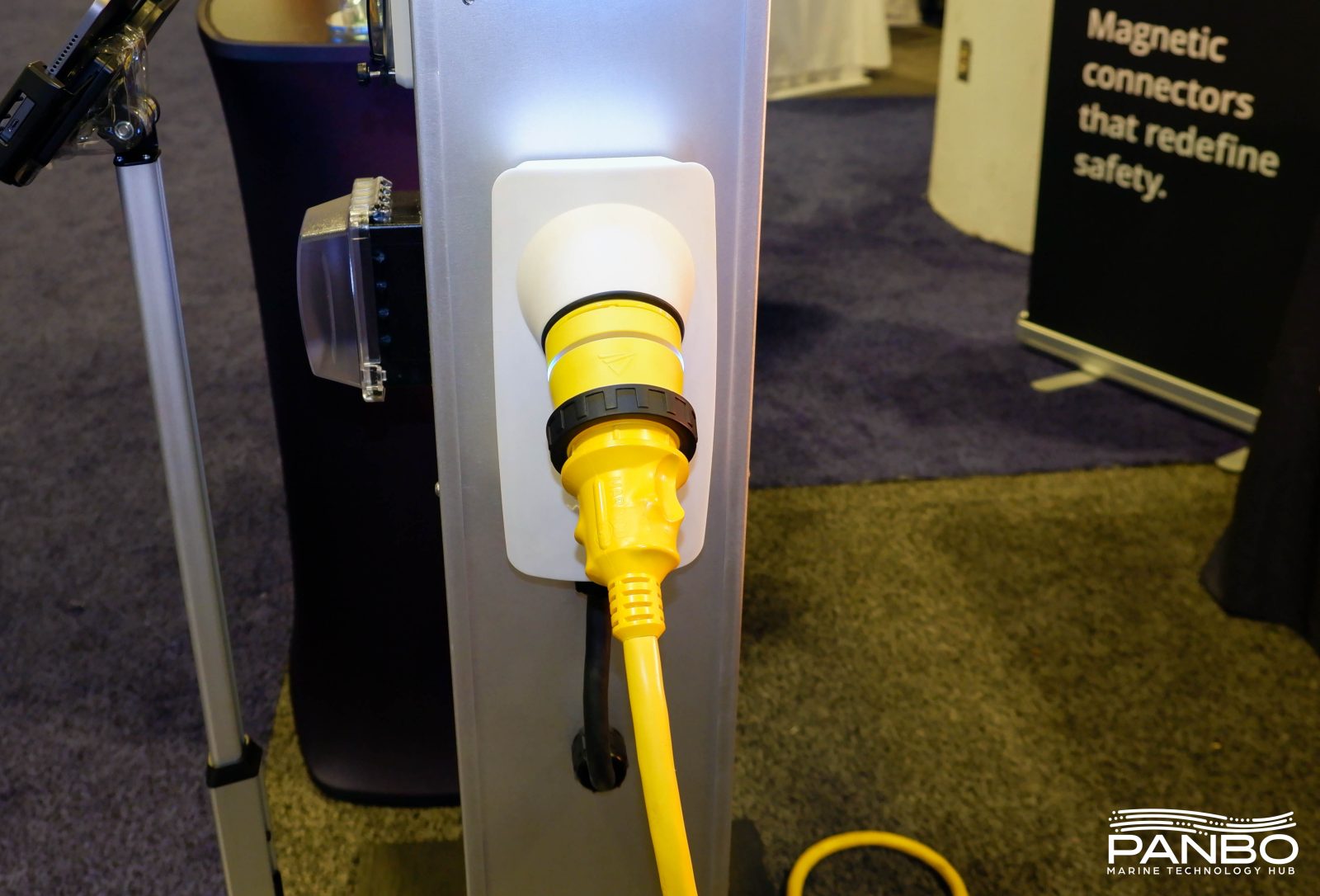
Recently, I participated in judging the NMMA’s Innovation Awards at IBEX. Participating in the awards affords me a sneak peek at new products and technology. This year’s IBEX was full of interesting and compelling new products. But, if I had to pick one product that I’m most excited about, VoltSafe’s managed shore power system is a strong contender. Let’s take a look at the system and why I’m excited about it.
When I first read VoltSafe’s submission materials for the innovation awards, I immediately figured it was a slightly different take on what SmartPlug has offered for quite some time. But, as indicated by VoltSafe’s innovation award win for electrical systems, there’s a lot more to their solution than a change of connectors.
Safety
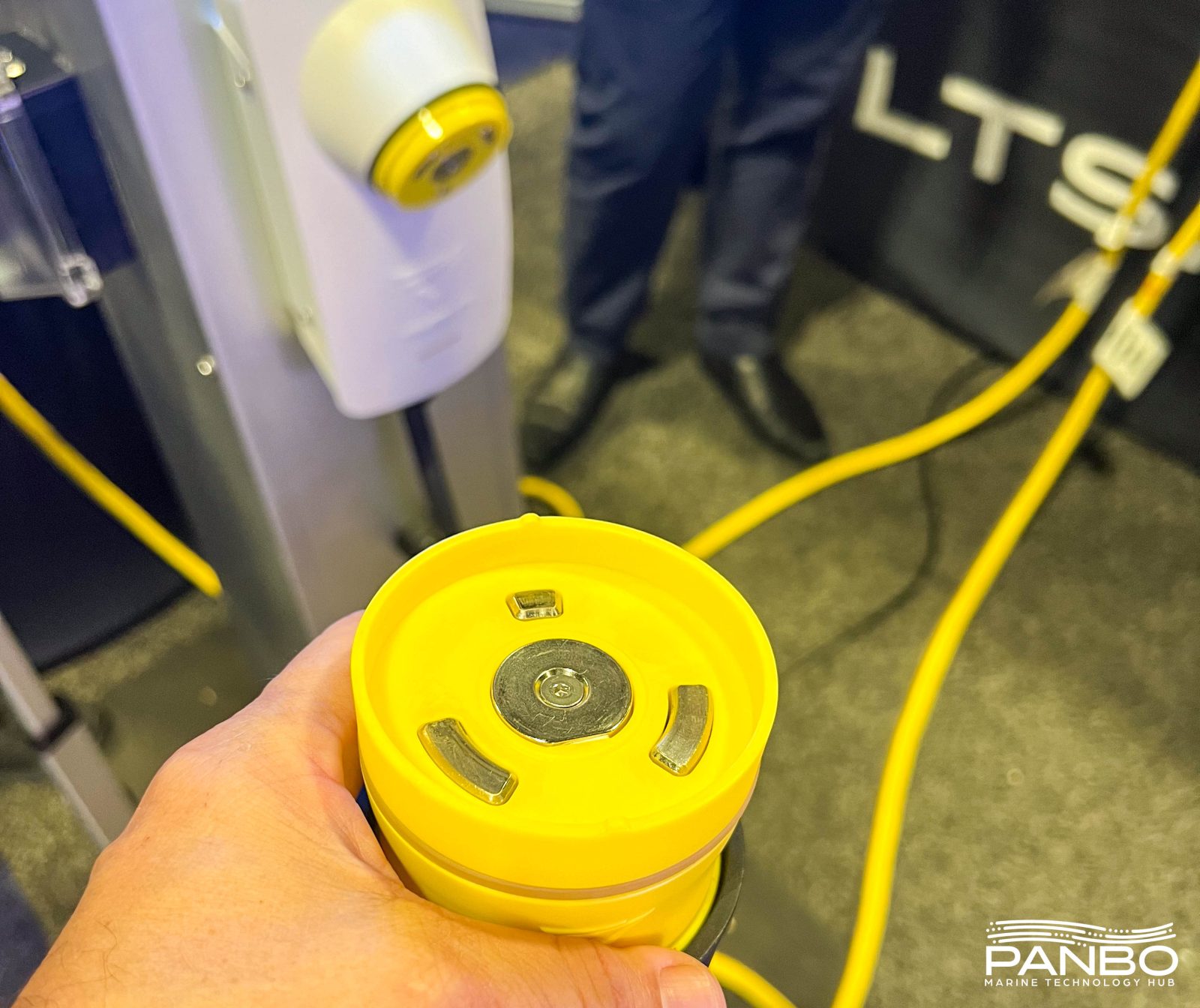
You may be thinking that the cord above looks an awful lot like the familiar 30 amp shore power cords. It turns out, you’d be right. What you see above is an ordinary 30 amp shore power cord with a small, puck-like magnetic adapter attached.
That cord end, with the puck attached, mates to VoltSafe’s pedestal-mounted unit. The puck attaches to the pedestal via a powerful magnet. The cord easily disconnects from the pedestal with a twisting motion. But, if a boater forgets to disconnect it, 40 pounds of force pulls it cleanly off without damage to the boat or pedestal.
With current shore power connections, yanking a shore power cord apart likely means either an energized receptacle or cord, depending on where it comes apart. That same situation would be a little more concerning with VoltSafe’s flat, relatively exposed conductors on their puck and receiver. But, there’s more going on with VoltSafe’s connection than what we see traditionally. The puck and the receiver negotiate with each other to ensure electricity isn’t allowed to flow until a good connection has been made. The negotiation mirrors the process used by electric vehicles when their chargers are connected.
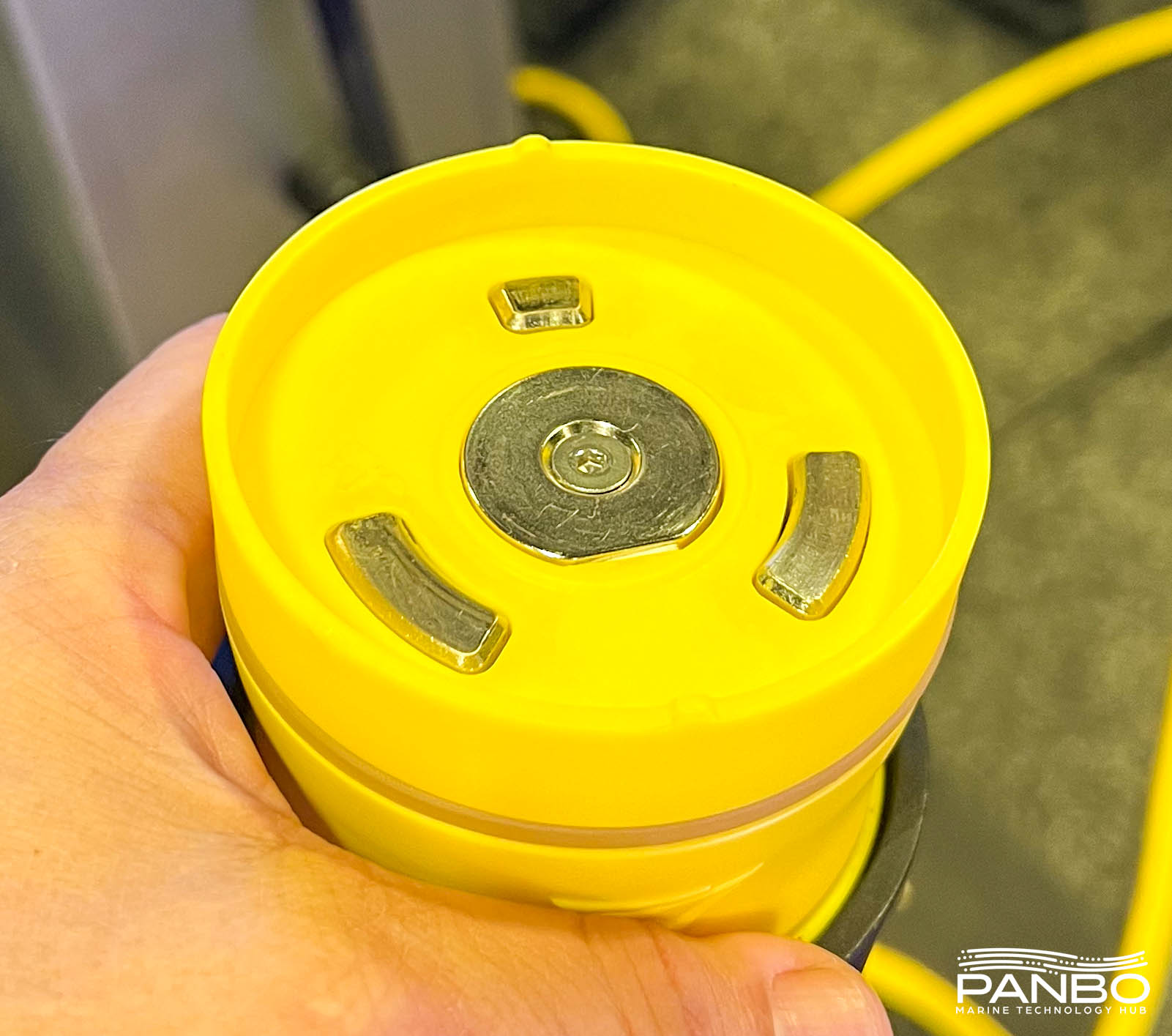
The nice big contacts combined with VoltSafe’s intelligence should all but eliminate the meltdowns we’ve likely all seen. Typically, these occur as a result of resistance at the small points of contact employed by current connections. One potential concern with those big, relatively easily accessed connections is accidental contact and shock. But, because VoltSafe is only sending power once a connection has been established, and ceasing to send power immediately if that connection is interrupted, that risk is mitigated. Also, the visible contacts mean that if there’s a problem with them, you can easily see it. That’s not the case with traditional receptacles in use today.
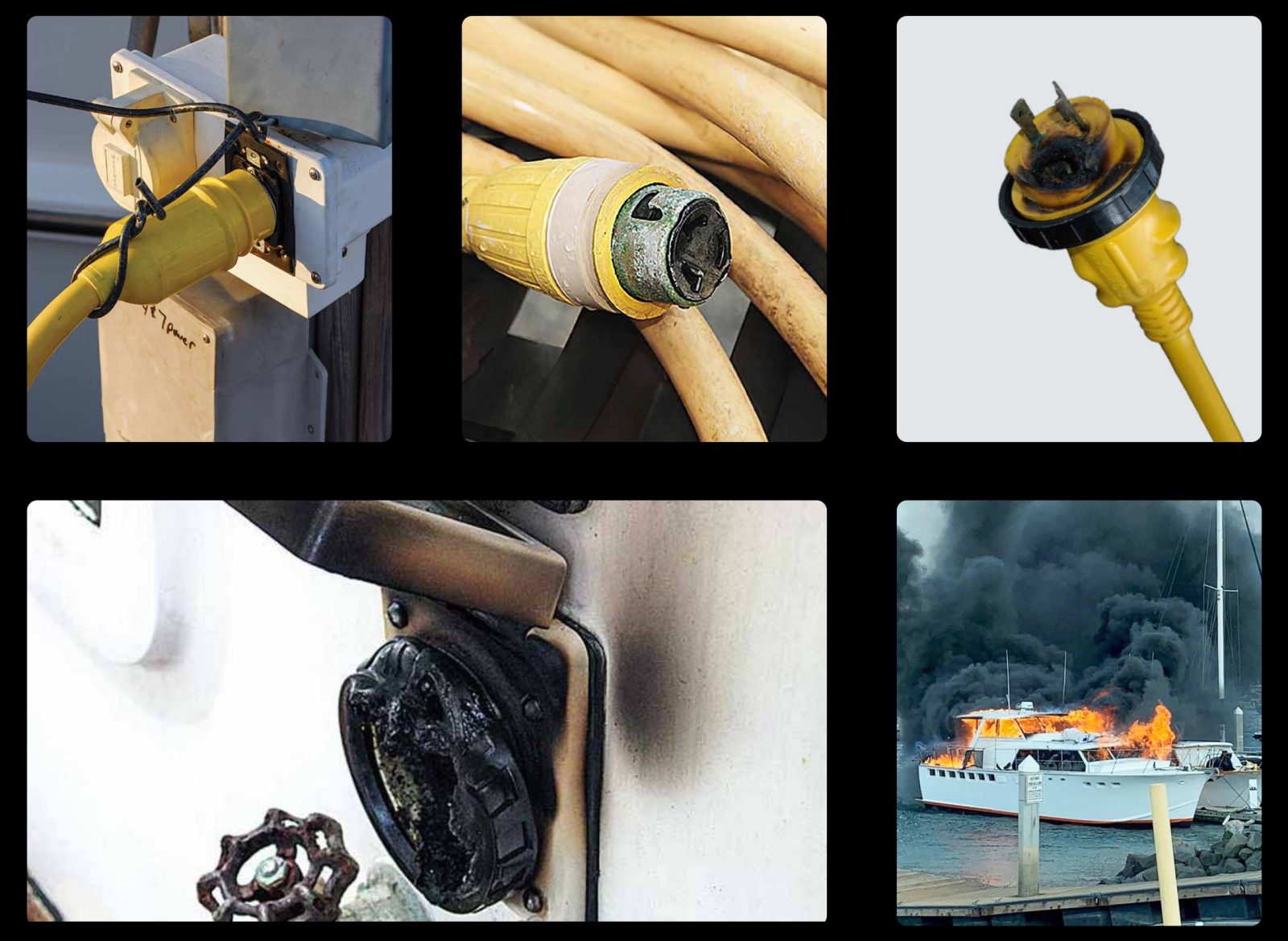
VoltSafe utilizes a temperature sensor in the outlet of their unit. So, if resistance builds in the connection between the puck and receptacle or the shore power cord and the puck, the system will detect increased heat. An alert generated before the connection gets too hot provides an opportunity to fix the problem before damage occurs.
Current leakage
Boaters who have encountered newer marinas with equipment leakage circuit interrupter (ELCI) breakers probably know the issues they can cause for both boaters and marina management. ELCI breakers typically don’t display any information about how much current leakage they’re measuring. Instead, they just trip when the value goes out of range. Often, these breakers are fitted at distribution points, so tripping a breaker results in a group of boats losing power. VoltSafe’s shore power electronics monitor ELCI, among quite a few other parameters, and allow real-time viewing of the data. Plus, a marina can set the trip threshold lower on a per-slip basis than the distribution point, so that one boat with an issue doesn’t affect others.
It’s not just leakage current and outlet temperatures that VoltSafe monitors. The system also watches for over and under-voltage situations as well as over-current protection. This thorough monitoring helps reduce the risk of damage to the boat and increases the safety of those on and around it.
Centralized management
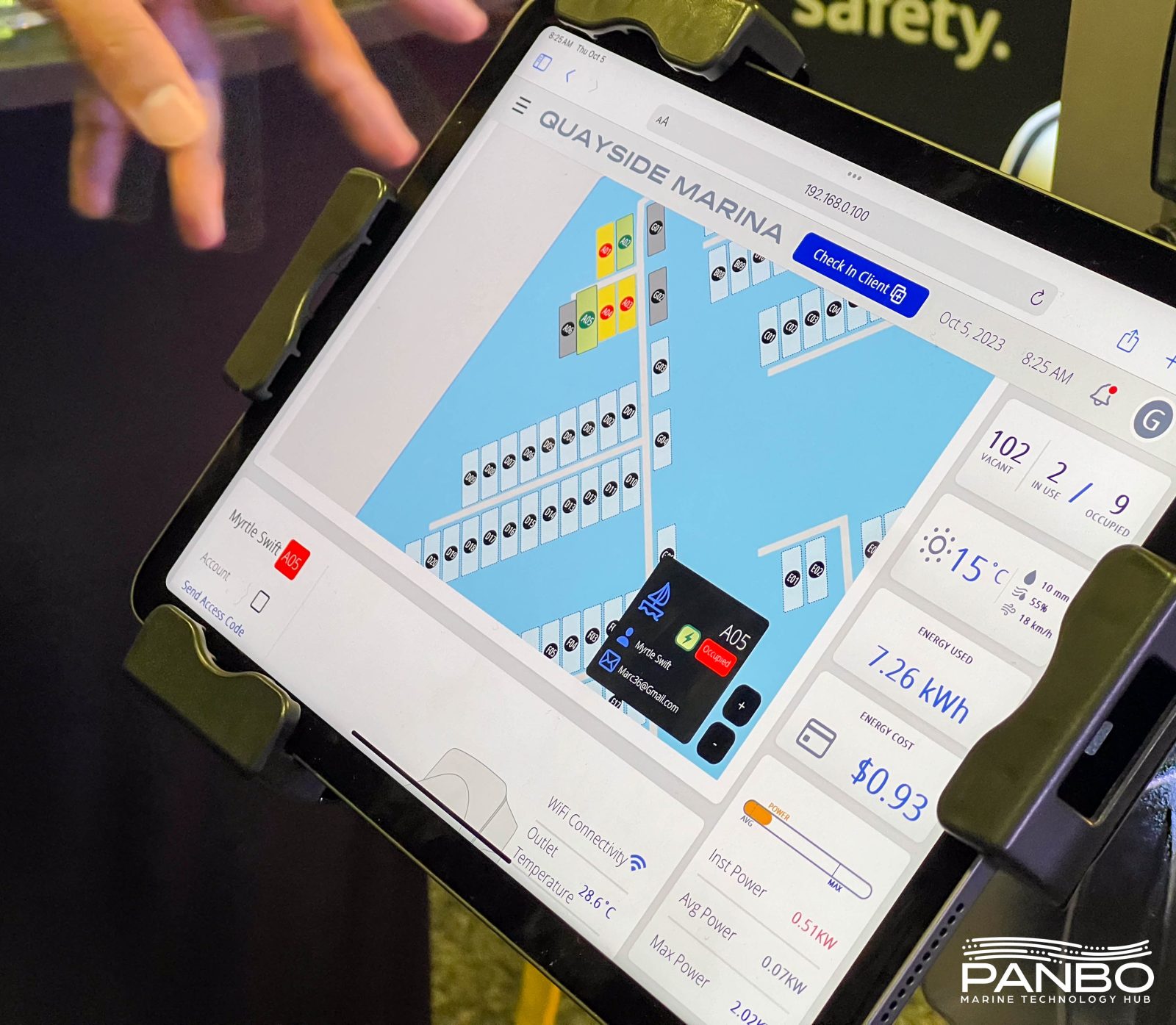
VoltSafe’s benefits don’t stop at safer shore power connections. Their actively managed power outlets combined with their WiFi-connected pedestal enable a new level of monitoring and management. These benefits most directly affect marina operators, but will also trickle down to individual boaters.
In a typical marina today, all pedestals remain energized all the time. Often, individual outlets are turned off by a breaker in the pedestal. Unfortunately, this approach means that visiting boats without a reservation are able to plug in and draw power. Often by a boat that arrives after the office closes and departs before it opens. VoltSafe can help with that problem by disabling pedestals for unoccupied slips.
Centralized control isn’t limited to just turning receptacles on and off. Accurately metering power consumption is a frequent pain point for marina operators. Plus, the manual collection of that data represents a staffing cost. VoltSafe’s centralized management platform will output accurate and timely consumption data.
The VoltSafe marina app allows marina staff to monitor and track the occupancy of the marina. Additionally, at a glance a marina operator can determine if any boats have come unplugged, are receiving low voltage, drawing too much current, or have any other concerns.
Slip holder’s app
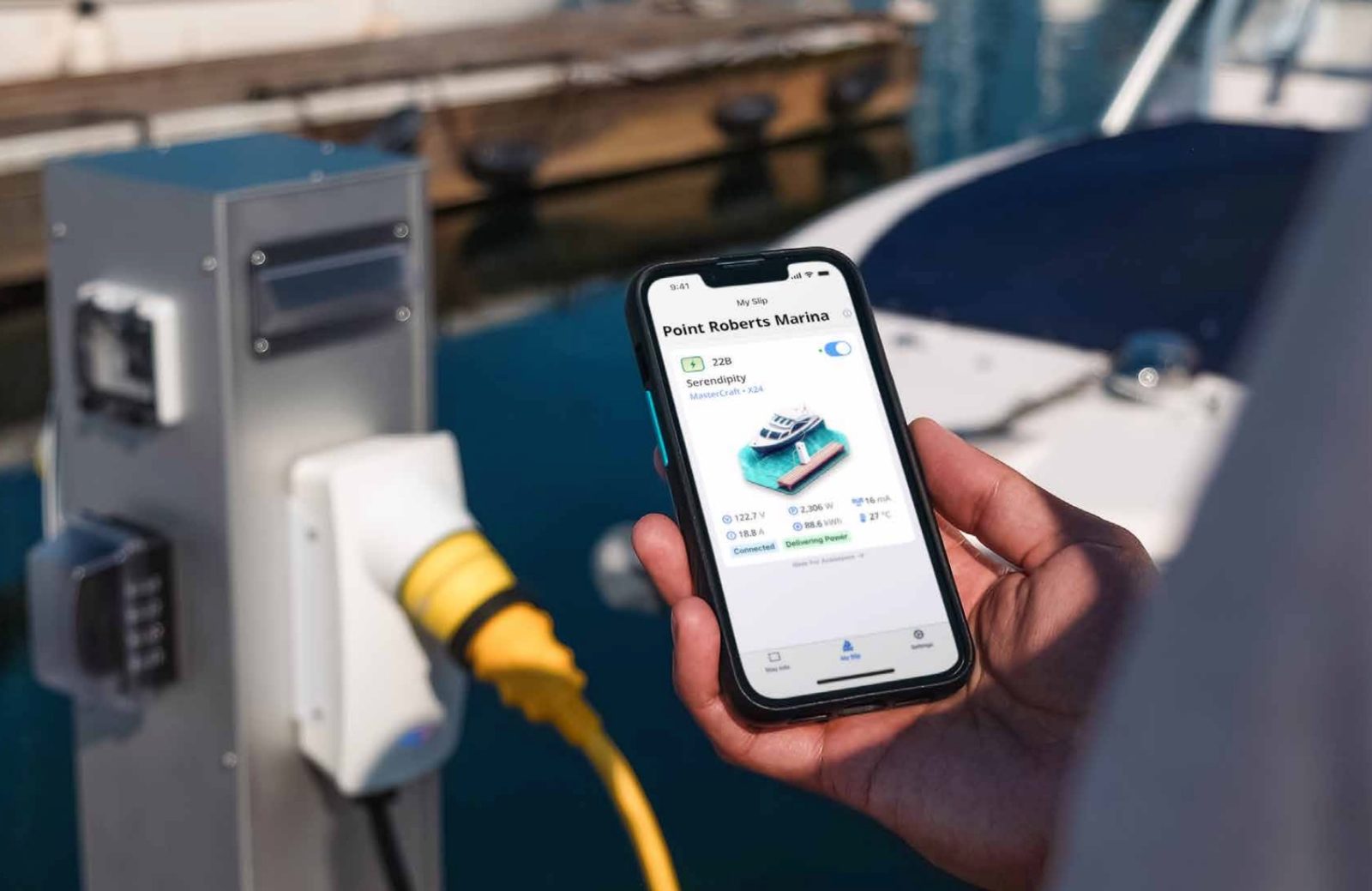
Most of the information available to marina staff will also be available to individual slip holders, for their shore power system. Many boaters, especially those in warm weather and air conditioning-intensive climates, have experienced the sticker shock of a month-end power bill. VoltSafe can eliminate that shock by allowing boaters to see their real-time power consumption as well as cumulative monthly usage.
The app’s utility to boaters isn’t limited to just understanding the cost of the power they consume. It also alerts a slip holder of a shore power disconnect. That alone can eliminate spoiled food and flat batteries. Lastly, the app aids both the boater and the marina in tracking down low-voltage issues. It’s not unusual during periods of heavy consumption for onboard appliances to struggle with low voltage. It can be difficult to know if that’s due to onboard wiring or because the marina is supplying low voltage. VoltSafe makes that clear at a glance.
Cost
VoltSafe hasn’t finalized pricing yet. But, they do say they expect their solution, including the shore power pedestal, to be cost-competitive with traditional pedestal and outlet packages. If they’re able to achieve that price parity, I’d say that represents a pretty compelling value proposition. The additional functionality and convenience for both the marina and the boater seem compelling.
What’s next?
As soon as I saw VoltSafe’s product, I was excited to see something that would, I thought, protect the entirety of the connection from the pedestal all the way through the boat. But, then I realized that, at launch, VoltSafe addresses the connector on the pedestal, but not the connector on the boat. It turns out they made a business decision that it would be easier to drive adoption by demonstrating their value and safety to a marina operator, rather than to individual boaters. But, fear not, they plan to address the boat side of the connection soon. The boat side connector will use the same magnetic connector approach and also feature temperature monitoring.
You may have also noticed that everything shown so far is for 120-volt, 30-amp L5-30 style receptacles. VoltSafe also plans to offer 50-amp, 240-volt solutions in the near future as well. Lastly, they intend to add control of pedestal water and include the same consumption metering capabilities as they offer for electricity.



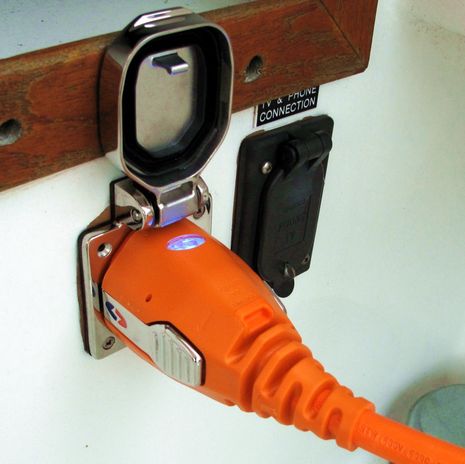










Sounds promising Ben – heavily dependent on the monitoring technology, however….my first thought is what happens when the pedestal “detects” an anomaly, and shuts off the power to the boat – when nothing obvious is amiss. Will your average dock hand have the technical know-how to troubleshoot this?
Also, I’m not clear on how you connect to it with a standard 30A cord – are they providing an adapter, or does it mean modifying your cord? And if the latter, how are you supposed to use your cord at traditional marinas?
Grant,
You’re right that there is a possibility of false alarms, though at least you could be notified of the trip and deal with it before it results in dead batteries and spoiled food.
There is a small puck that connects to the shore power end of a 30A cord. That puck then mates magnetically to the VoltSafe unit.
-Ben S.
Thanks Ben, I see the puck in the pictures, wasn’t sure how it attached to the cord. So if the puck uses the standard twist-lock (kind of a misnomer, as it certainly doesn’t “lock”) of the original Hubbell design, then I’m not sure all that technology is going to help much. You still are dealing with the inherent physical deficiencies in the original connector, except now it’s between the male cord end and the female puck. Don’t mean to be a naysayer, and all the associated tech benefits are definitely cool – it just seems like the achilles heel of the physical connection still exists.
For now, there is still some of the achilles heel. But, bear in mind, the puck has a temperature sensor, so it will know if the connection gets hot. Hence, it will kill the power before a meltdown occurs. Otherwise, you’re right that for all the goodness the system could offer, VoltSafe needs to offer an end-to-end connection without any of the weak link connectors in place.
Best,
Ben
We also prefer to deliver the end to end solution (already designed). However, instead of forcing boat owners to spend more $ on yet another expensive electrical cord, we are first offering the inexpensive adapter to make use of their existing cord set. This is where the locking ring comes in handy on L5-30 corsets as we have a gasket that ensures significant water resistance between existing prongs when mated to our adapter (compresses gasket when screwing the locking ring tight).
VoltSafe provides adapters that locks (screw threads onto a boat owners existing L5-30 plug. VoltSafe tech does monitor over-voltage and over-current, but follows industry standards state by state when hard setting what our technology does in response. Grant, you are right to bring up concerns about nuisance tripping because that would defeat the benefits of the technology. The electrical fingerprint (adapter) must match within a preset tolerance of impedance and outside of this tolerance (a much higher resistance value would result in a potential meltdown. Instead your phone would instantly notify you to inspect and clean you contacts to resolve. One of the additional challenges we’ve continued to see play out in the marina ecosystem relates to better standards associated with reducing current leakage at marinas. Plenty of old boats and ones with poor upkeep that leak current into the surrounding water causing galvanic corrosion and ESD risk (especially in freshwater). VoltSafe tech shows real time current leakage from boats (through hot/neutral) and can also detect leakage from other sources (through ground) aka surrounding water. This allows us to create a leakage heatmap to assist marine electricians identify the source(s) of current leakage in their marina. Standards bodies have imposed adoption of ground fault circuit breaker.
Trevor Burgess – VoltSafe CEO|Cofounder
Thanks Trevor – I didn’t realize the adapter thread-locks on to the existing L5-30 plug of the shorepower cord – that’s certainly an improvement. The rest of the technology sounds very promising. I share your concern about current leakage, and your system sounds a great way to track that down. Hopefully you can convince marinas to invest in the improved technology!
We (VoltSafe) are currently in Newport Oregon this week as part of the 50th annual Pacific Coast Congress of HarborMasters and Port Managers. We are actively pilot testing at many of these locations Port Authority locations. A big challenge they have relates to adopting the latest NEC 30mA ELCI (GFCI) requirements. Even if marinas are willing and able to absorb swapping $20 30a breakers with $250 ELCI 30a breakers, they still have the challenge of identifying the sources of current leakage and resolving. https://pccharbormasters.org/wp-content/uploads/2024/03/Newport-Draft-Agenda-V4.pdf
It looks like I might not be the only one who’s backed out of the berth, forgetting to disconnect the power cord. I’m comforted!
Until VoltSafe launches their boat-side solution, this product is highly dependent on marinas adopting this technology. So nothing for the average boater to look at yet.
Bruce, when we set out to deliver a shore power solution, we did so on the boat side first. In fact, the design is done and functional prototype tested (works really well). The product had L5-30 prongs that plug into normal pedestal and cord terminates with our native connector. Boat owners would need to retrofit their existing boat shore power inlet with an adapter (looks like a hockey puck) and voila! The product is already at the final stage of commercialization, but triggering this stage is the most expensive (>$1M in sunk costs) and as a startup company we needed to ensure we landed in the market correctly out of the gate. What we realized was that the marina operators needed the pedestal side solution even more than boaters.
Thanks for your reply, Trevor. I’d be interested in a beta trial of this product when it launches. Can you let us know here when it launches? And the cost?
The navy is currently pilot testing product prototypes. Because this will primarily be consumer focussed, we will likely look to gauge interest on indiegogo/kickstarter. In advance of that we can also add you to our priority list by emailing us at [email protected] or here https://www.voltsafemarine.com/contact
This sounds like great technology that won’t fly unless VoltSafe licenses the technology to other pedestal/cord manufacturers. Imagine all of us needing to carry the cord side of this device for the one marine we see with this tech or the one marina trying to manage their loaner devices for transients. Additionally, there are few marinas trying to upgrade their power distribution unless it is failing (as in on fire) or mandated. In Michigan, the state-run marinas are already changing to add the ELCI breakers, but since this is already being done VoltSafe is too late. Poor imagination on my part I’m sure but I don’t see how this gets rolled out. Maybe if all the manufacturers jump on . . .
Dan, I hear you and you absolutely bring up some great points. At https://www.voltsafemarine.com you will see the 3rd pic as you scroll down shows the simple adapter piece. It takes 10sec (5sec if your speedy) to lock it to a standard shore power cord and faster to remove. It also happens to be very inexpensive to replace. Marinas even use it for transients where the software does a CC pre-auth, just like a hotel does for a damage deposit in case they forgot to return. VoltSafe sits on the American Boating and Yachting Cousel and indeed more than 60% of marinas in North America have pedestals being >10years old. The new 2023 NEC mandate requiring marinas switch to using breakers (at the pedestal) that are (ELCIs) essentially Type B GFCIs that trip at 30ma in <100ms means every power outlet (30/50/100A) will need a matching ELCI breaker installed. So far only 4 out of 50 states have adopted this. Why? Because the damn ELCI breakers cost $250-$350/breaker (standard 30A breakers cost $20-30) which is ~$120k for a 400 slip marina just in breaker upgrades alone. Our units offer future proofing for when additional states continue to adopt the 2023 NEC code because the hardware inside our tech will serve as a 30A ELCI (but at no extra cost to customer).
VoltSafe may want to conform their pedestal to NFPA 70 National Electrrical Code which includes Article 555 Marinas, Boatyards, Floating Buildings, and Noncommercial Docking Facilities. It would be much better to adopt the current standard than to try to get it rewritten for their design. NFPA 555 is very specific and describes existing pedestal and receptacle designs in great detail. From the pictures, it seems VoltSafe didn’t address the electrical details and what NEC defines as a “Marine Power Outlet”.
The technology looks great and it’s something that the big players like Eaton Marina Power should take notice of.
I would agree – I would think that NFPA compliance would rate MUCH higher with marinas (due to their insurance and state law requirements) than convenience of their customers. We are seeing the result of the NEC Art 555 30ma compliance in many newer marinas, and lots of boaters are unhappy about having to modify/repair their vessels to keep the ELCI breakers from popping – I’m not sure an additional layer of complexity wold be welcomed 🙂
FWIW, its NFPA 303 that specifies the connectors, and since I can’t find an online copy (and I’m too cheep to spend serious money on one), I’ll leave that subject to others.
Hartley
I went a bit further down this rabbit-hole.. I did find NFPA 303 online free (Thanks, NFPA!!) but they only include illustrations of pin & sleeve connections for 60 and 100 amp connections. For 30 & 50 amp connections, they refer to UL 231 and require UL listed components.
UL 231 is not available online, so I couldn’t look any further (though they do refer to “locking” connectors).
So it looks like if a marina wants to be NFPA (and , therefore NEC) compliant, they would need to utilize UL-listed connectors.
Hartley
I think this is an interesting question and, at least in my opinion, a shame of a way for a potentially better connector to be stymied. I’ve reached out to Voltsafe to ask them about standard and code compliance. But, I’m also wondering about how something like SmartPlug would meet these same requirements.
-Ben S.
Hi Ben! It looks to me like the NFPA and UL stuff applies ONLY to the shore side, while the much more voluntary ABYC standards apply to the boat side. This means that marinas are the tougher end of the equation – most will need to stay within their insurance requirements (which are likely to be tied to the NEC/NFPA standards).
This may explain why SafePlug didn’t really go after the shore-end of the business – the regulatory hurdles may have been too tough/expensive to make it doable.
I think it would be nice to have a safe “breakaway” shoreside connector – something less dramatic than destroying the connector or breaking the wires!
Hartley
Indeed correct Hartley and there are nuances to these standards. All safety certified electrical products for sale in USA must conform to UL standards and in Canada CSA. which is different than actual safety certification testing to these relevant UL standards (which apply to the product in question). Testing can be done by any NRTL (Nationally Recognized Testing Laboratory) to UL standards. UL happens to also be an NRTL. https://www.osha.gov/nationally-recognized-testing-laboratory-program/current-list-of-nrtls
If i was a marina operator, I certainly would be frustrated with the added cost of ELCI breakers ($30 versus $300 for ELCI) AND the nuisance of trying to figure out the existing leakage sources from all the countless leaky boats in the marina. If a marine electrician just goes ahead and upgrades to ELCI breakers, likely the first thing will happen is that many branches of electricity will trigger the 30mA ELCI threshold immediately and he will then have to: 1) put the old breaker back in 2) test the water and boats slip by slip to pinpoint the source(s) of leakage 3) then figure out a remedy 4) once all fixed then re-replace the 30A breaker with the 30A ELCI breaker. So fun! VoltSafe Hardware and Software Solutions work together so that: marina operators can view the leakage at each slip in real time (due to the boat) AND leakage coming from other boats and/or sources (dock) into slip boat through earth. This real time data serves to create a marina leakage heat map that pinpoint the problems and is actionable for marina electricians at outset. We expect our hardware to also end up compliant as an 30A ELCI breaker also, meaning when you install a VoltSafe shore power unit you won’t need to also spend $300 on a 30A ELCI breaker. For states that currently haven’t adopted the 2023 NEC code, the VoltSafe ELCI breaker trip leakage is software tunable by the marina operator. For states that have already adopted the 2023 code, the trip leakage would be hard locked to match law at 30ma <100ms trip.
Voltsafe has great new technology for marina power management.
Since any new commercial construction has to meet the State’s adopted NEC code version, Voltsafe might start by taking an already UL listed “marine power outlet” (pedestal) and adapting it for their improved connector and power monitoring. If it’s an enhancement to an already approved device, the Professional Engineer and the State Inspector would be more inclined to approve its use.
Agreed. Excuse the pun, but it’s shocking that only 4 of the 50 states have adopted the 2023 NEC code version, requiring marinas to use of Type B GFCI breakers (aka ELCI with 30ma trip in <100ms) at pedestals. The reality is that marinas in the other 46 states understandably don't want to replace $20 30A breaker with $250 ELCI 30A breakers, nor face the mess of current leaky boats. No doubt a huge PIA (pain in ass).
Regarding safety certification to UL & CSA standards, VoltSafe does indeed have a path to (successful) certification.
Good points all, but none of it eliminates the 1930’s Hubble twist-“lock” connector, which is the underlying weak point that makes everything else critical to preventing a disaster. As long as that’s part of the connection, we’re just treating the symptoms instead of the problem. I get that the industry and governments don’t want to legislate thousands of existing power cords unusable by mandating a long-overdue improved connector. But that’s ultimately what its going to take. Comparatively, many, many boat owners were forced to correct electrical issues on their boats to use newly-mandated ELCI-equipped marinas, and typically at much greater expense than a new shore-power cord….
David, I doubt the pedestal is what needs to be listed, but rather the actual fixture (outlet itself) that has to be UL-listed. If the whole pedestal is listed, then none of the component parts can be changed without all-new testing.
Grant, you’ve hit the nail on the head – we would ALL like to see something to replace the “twist-lock” connectors! But I suspect that they remain the only 30 – 50 amp connectors that meet the UL spec (I’d love to hear what that spec entails – especially the “locking” part!)
In the mountaintop radio site biz, we used 15 and 20 amp “twist lock” fittings in some sites, mostly so we could mount the fixtures overhead, facing down. A normal 15 or 20amp fixture won’t reliably retain a plug like that unless you tie the cord up to the structure, but we had no issue with those sizes of “twist lock” actually locking. In my experience, the 30amp twist-locks don’t “lock” worth a hoot – I’m not sure if they just wear out, or if the design is deficient. 50amp fixtures are much better, probably due to the metal outer sheath, which is significantly stronger than the pins alone which the 30amp uses for support.
We went to SafePlug for the boat end on our vessel, but the other end of the cord is still the olde 30a twist-lock stuff, and it is obvious that it is NOT an optimum solution, especially after a few years and lots of use.
I’m thinking there is a lot of inertia involved here – the twist-lock fixtures are UL-listed, the design is no longer proprietary (so cheap to copy) and the marine market is not big enough to support the kind of investment needed to supplant the olde twist-lock standard.
A potential manufacturer (like Voltsafe) has to be counting on being a sole-source provider for a long time in order to recoup the investment needed to get their stuff through the approval process – but us users would rather see something that is NOT “sole-source” to keep the costs down – a tough situation. One does wonder if the IEC series of connectors offers anything that would be approvable without the well-know issues of the twist-lock stuff?
Hartley
Yes, a lot of inertia to be sure.
You said you went to a “SafePlug” for your boat end – I’m guessing you meant “SmartPlug”? That’s what I did as well, at least one end is secure! My home marina pedestals have threaded fittings, so at least I can use the Marinco locking collars to secure that end – but many marinas don’t have that provision.
I havent seen any IEC-style plugs that include a physical strain relief (like Smartplug), or even any kind of twist-lock retainer.
If anyone knows the ins and outs of this, it’s probably SmartPlug – they’re the only ones that I know of who have developed a superior product. I just don’t think we’ll ever see it in widespread use among marinas unless it’s mandated by code.
Yes, I should have said “SmartPlug” 🙂
The IEC connectors the Europeans are using (ex: https://www.eaton.com/content/dam/eaton/products/wiring-devices-and-connectivity/wiring-devices/pin-and-sleeves/16a-and-32a-iec-309-watertight-pin-and-sleeve-devices-spec-sheet.pdf ) are pin and sleeve – the same sort of design mandated for 60 and 100amp boat connections by the NFPA. They “lock” in with an external sleeve, similar to the screw-in collars in use on Marinco and others, but it appears to be a bayonet, not a screw thread (a good thing, I think!). Hard to say if they would meet UL 231 requirements.
I’ve reached out to and heard back from VoltSafe. They will hopefully be responding to this thread shortly. The response is likely a bit delayed due to their office being closed for the holidays.
That said, I’m in total agreement with Grant and Hartley’s sentiments about the goodness of an improvement over the existing twistlock connectors in use in marine. I routinely explain to boaters that their melted shore power cord wasn’t the result of a short circuit or any other extraordinary event, rather just poor design and a little age. That explanation is usually met with either skepticism that I’m full of it or surprise that this is what we have to work with.
I’m hopeful that something can be done to improve upon this and while it is indeed single source, I think what VoltSafe has designed improves upon the current circumstances in nearly every regard. Now we have to see if the approvals and code compliance can be sorted out.
-Ben S.
My experience with the Marinco and Hubbell shore power cords is that boat owners are prone to mis-using them. Often there is no strain relief at the pedestal and not enough slack between the dock and the boat creating undue stress on the connectors and eventually failure.
My pre-departure checklist now includes turning off the circuit breaker in the pedestal before unplugging the cord at the boat.
The more you learn about electric shock drowning (ESD) the more you find that it is preventable.